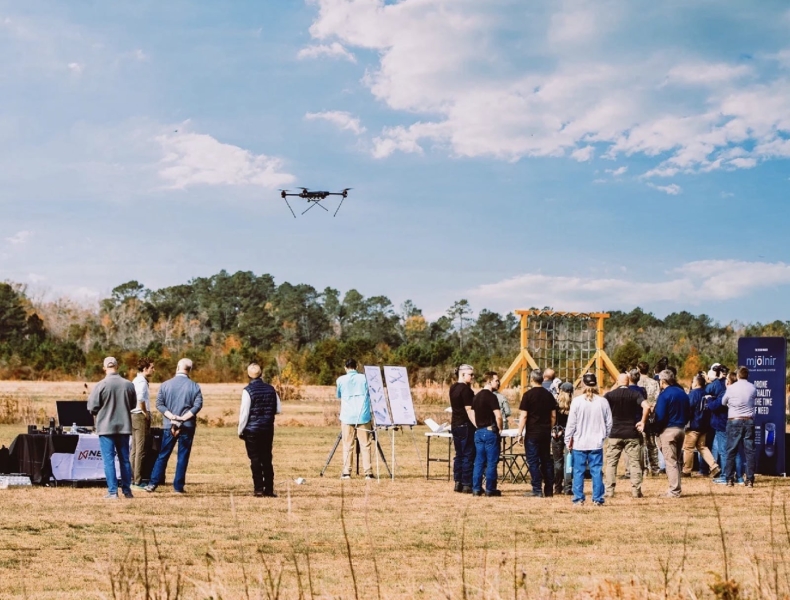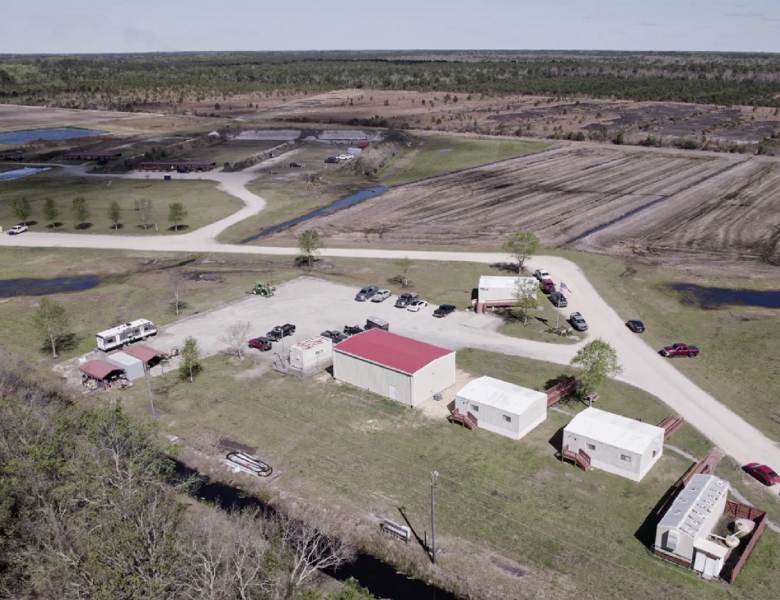North Carolina’s ‘Drone Audition’ Model Shows How Pentagon Plans To Accelerate Military Innovation Beyond Failed Replicator Program

Based on reporting by Dan Barkin for Business North Carolina
A first-of-its-kind drone competition in rural North Carolina is quietly prototyping how America might finally close its innovation gap with Ukraine’s battlefield laboratories—by letting military commanders “audition” new systems at civilian facilities and buy them within months instead of years.
Dan Barkin attended and reported on the inaugural event for Business North Carolina, providing on-the-ground coverage of the October 8-9 competition at The Range Complex near Autryville. The event drew approximately 170 participants including military personnel, academic researchers, drone manufacturers, and international companies—all testing systems in realistic tactical scenarios that would be nearly impossible to replicate on military installations. Organized by the Fayetteville Cumberland County Economic Development Corporation (FCEDC), the competition represents a direct response to recent Pentagon policy changes that are reshaping how America buys military drones.
“One of the thought processes is a lot of these folks out there are doing some pretty innovative things on their own, as well as industry and academia,” Rob Patton, FCEDC executive vice president and retired Army colonel, told Barkin during his visit to the competition.
Patton explained the rapid-iteration model the organization hopes to establish: “That gives innovators six months to develop what the military is looking for. We do it again. They come out, test it out. The next one, they say, ‘Hey, I like it.’ They can buy it.”
Barkin’s reporting from the Range Complex revealed how this civilian testing ground is becoming a critical bridge between military requirements and commercial innovation.

Policy Shift Enables Rapid Military Drone Procurement
The event’s timing coincides with sweeping changes to military drone acquisition. In July 2025, Defense Secretary Pete Hegseth issued a memorandum reclassifying small drones as “consumable” supplies, allowing O-6 level commanders—Army and Marine colonels and Navy captains—to authorize drone purchases, testing, and training without lengthy Pentagon approval processes.
This represents a fundamental departure from traditional defense procurement that typically requires 12-18 months or longer. Under the new framework, a colonel who sees a promising drone system at a facility like The Range Complex could potentially authorize its purchase within weeks under newly delegated authority.
The Senate’s draft National Defense Authorization Act reflects this strategic pivot, mentioning “unmanned” systems 126 times—more than triple the frequency in the 2010 version. The shift comes as drones have proven decisive in Ukraine’s conflict with Russia, fundamentally reshaping modern warfare doctrine.
International Interest Signals Broader Supply Chain Realignment
The competition attracted significant international participation, underscoring the global dimensions of building a domestic drone ecosystem. Vivien Yang, co-founder and CEO of Taiwan’s VoltaSphere Technology, attended to evaluate potential U.S. manufacturing locations for drone batteries—components that have become critical vulnerabilities in American drone supply chains.
Barkin spoke with Yang at the event, where she explained her company’s strategic rationale. “Our project is basically to do a China 2.0 in the US,” Yang told him. “So some of our shareholders, they have, like I just mentioned, they had a battery pack plant in China supplying batteries for commercial EVs in the US. So the customers were American, and it became really obvious back in ’22, ’23 [of the need] to move out of China. So the customers were like, ‘OK, come move to the US, set up a production plant, because the U.S. really, really needs batteries.’”
VoltaSphere’s interest reflects Taiwan’s strategic hedging as Chinese military pressure intensifies. Taiwan has adopted similar “consumables” reclassification for small drones and plans to acquire 48,750 domestically produced drones by 2027.
Canadian participants from Quanser, a Markham, Ontario-based company, demonstrated their turnkey drone education systems. The company addresses a critical gap as colleges scramble to establish drone programs but struggle with equipment selection, curriculum development, and lab setup.
“And so if a professor buys a control studio to teach controls, they also don’t have to go and design all their own lab content and all that. It’s really out of the box,” Patrick Barnard, a Quanser representative, explained to Barkin.
The Range Complex: Where Special Forces Training Meets Commercial Innovation
The 1,982-acre (8 square kilometers) Range Complex provides infrastructure specifically designed for drone testing that military installations struggle to accommodate. The facility features tactical pistol and rifle ranges, a 600-yard (549-meter) long-distance range, and live-fire shoot houses—environments where drones can demonstrate capabilities in realistic scenarios.
Bryan Bailey, Range Complex president and retired Fayetteville police sergeant who led the department’s Emergency Response Team, gave Barkin the facility’s background. Bailey explained that the Range Complex originated as part of TigerSwan, an Apex-based global security firm founded by retired Delta Force lieutenant colonel James Reese. The Range Complex was sold as a separate entity in 2014 and now serves military units, police departments, and companies testing drones and ground vehicles.
Security and access challenges make military bases ill-suited for rapid commercial testing. “Just getting folks through the gates of an installation is a challenge because of security,” Patton told Barkin. “And flying any kind of unmanned aircraft on a base is not easy, especially lately, what with strange drones buzzing installations.”
The Range Complex model solves this friction by providing DoD-compliant testing infrastructure in a civilian environment where international participants, academic teams, and startup manufacturers can demonstrate systems without months-long security clearances. As Barkin observed during the event, FCEDC plans to build a defense innovation center including a sensitive compartmented information facility (SCIF) for classified meetings with military leadership.
Ukraine’s Combat Lessons Drive American Urgency
The drone competition reflects urgent lessons from Ukraine’s conflict, where unmanned systems now account for 70-80% of battlefield casualties. Ukraine currently deploys approximately 9,000 drones daily and produces roughly 200,000 monthly—a consumption rate that would exhaust America’s entire annual production in approximately four months.
The contrast is stark: while Ukraine’s necessity-driven innovation cycles produce new drone variants weekly, America’s traditional defense procurement measures timelines in years. NATO members are now learning from Ukraine rather than training Ukrainian forces, with countries like the UK, Netherlands, and Denmark establishing joint production deals to access Ukrainian drone technology.
As Barkin noted in his reporting, Russia’s February 2022 invasion and OpenAI’s November 2022 ChatGPT release both accelerated what participants described as the “Decade of the Drone” intersecting with artificial intelligence advances. These parallel developments created strategic imperatives that traditional defense acquisition systems couldn’t address.
DroneXL’s Take
Dan Barkin’s reporting from The Range Complex captures something the drone industry press has largely missed: this North Carolina event matters far more than its modest 170-participant scale suggests. It’s a prototype for something the Pentagon desperately needs: a way to escape the procurement death spiral that just killed the billion-dollar Replicator program.
We reported two days ago that the controversial DOGE unit seized control of military drone acquisition after Replicator’s spectacular failure—technical breakdowns, interoperability nightmares, systems that couldn’t perform in Pacific distances they were supposedly designed for. Before that, we detailed in September how multiple Replicator systems repeatedly failed during testing, with reconnaissance craft drifting due to steering failures and target-recognition software collapsing during military drills.
The Range Complex “audition model” attacks the root problem: traditional procurement selects systems based on specifications and promises, then discovers fatal flaws only after spending hundreds of millions. This approach lets commanders see, touch, and evaluate systems under realistic conditions before committing resources. It’s how Ukraine has been developing drones for three years—rapid iteration driven by immediate battlefield feedback.
But here’s the reality check that nobody at this event wanted to emphasize: Ukraine deploys 9,000 drones daily. The Pentagon’s new DOGE-led effort targets 30,000 drones over months. Ukraine plans to manufacture 4.5 million FPV drones in 2025 alone. The scale mismatch is almost comical if it weren’t so strategically dangerous.
What The Range Complex model does provide is speed and ecosystem development. VoltaSphere’s presence underscores a critical lesson from Skydio‘s October 2024 supply chain crisis, when Chinese sanctions cut off battery supplies and exposed how dependent American drone manufacturers remain on components they don’t control. You can’t build a domestic drone industry with just drone manufacturers—you need battery makers, training systems, testing infrastructure, and talent pipelines.
The policy shift allowing O-6 commanders to directly authorize purchases matters enormously. We’ve covered extensively how the Army’s new “drone marketplace” aims to collapse 12-18 month procurement timelines into weeks. But procurement speed means nothing if you’re buying the wrong systems, which is exactly what happened with Replicator.
Taiwan gets it. They reclassified small drones as consumables in August 2025 and are racing toward 48,750 drones by 2027 while hedging their manufacturing supply chains. VoltaSphere’s presence in North Carolina signals that Taiwanese companies see the same vulnerability in American supply chains that Beijing exploited against Skydio.
The real question is whether America can scale these lessons before they’re needed. Events like this North Carolina competition provide the testing ground. DOGE’s intervention—controversial as it is—acknowledges that normal Pentagon channels failed. Whether this civilian-military partnership model can actually deliver thousands of combat-ready systems remains unproven.
Ukraine had no choice but to figure this out under fire. America still has the luxury of time to learn from their experience. How much time depends on what Xi Jinping decides about Taiwan, probably sometime around 2027 according to most intelligence assessments. That gives these North Carolina experiments about 18 months to prove the model works at scale.
What do you think about this rapid-iteration procurement approach? Can civilian testing facilities like The Range Complex help America close the drone innovation gap with Ukraine and China? Share your thoughts in the comments below.
